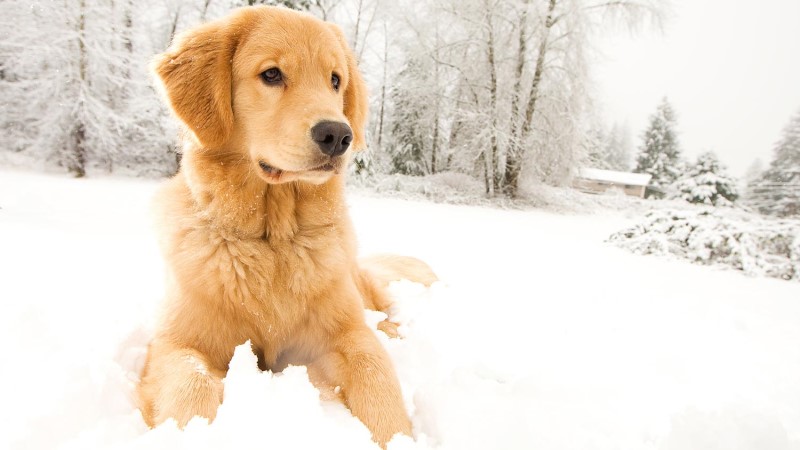Most pet owners are aware of the risks that loom over their canine companions in the summer months, but many people don’t realize the hazards that accompany the winter season. Cold temperatures, ice, snow, and deicing chemicals are all things that pet owners need to be cognizant of as winter months approach. Here are a few tips that we want to share to ensure you and your pup have a fun, safe holiday.
Keeping Dogs Warm
Early, winter mornings are especially dark and chilly. Try to walk your dog a little later in the morning when the sun shines bright. If it is difficult to get outside during those fleeting daylight hours, wear reflectors and fit your dog with a light up leash and collar.
Different breeds of dogs are going to require different winter cold protection. Some breeds of dogs, like Siberian Huskies and Akitas, are naturally prepared for winter weather with fuzzy fur and thick undercoats. These dogs need minimal winter warmth protection and actually delight in the dropping temps.
Short-haired breeds and slender breeds with little body fat, like Doberman Pinchers and Greyhounds, not only get cold more easily, but are also more susceptible to hypothermia. Hypothermia is a true medical condition characterized by abnormally low body temperatures. Extra precautions should be taken with these dog by minimizing their time outside and possibly even protecting them with a canine coat or sweater.
Winterize Your Dog’s Area
No matter the breed, you should never leave your dog outside or unattended for extended periods of time in extremely cold temperatures. Even the fuzziest of dogs get cold! If you are in a region where heavy snow dominates the winter months, clearing snow from walking paths and keeping a potty area free of snow is helpful. Small breed dogs will be very appreciative!
Drink Water—Not Ice
Freezing temps result in frozen water bowls. Your dog needs to stay hydrated, even in the cold. If your dog is accustomed to having access to water outside, be sure to check water bowls and dump ice and refill with water as needed.
Outdoor Safety
Another unexpected winter hazard is a frozen body of water. When a lake or pond is frozen and covered in snow, a dog doesn’t know what’s land and what’s water.
Falling in a frozen lake has many dangers. The freezing water can lead to hypothermia. In addition, sometimes dogs cannot scramble out to safety. The inability to get traction and the hazards of a person venturing onto the ice to assist can lead to an additional catastrophe. The best precaution is not to allow your dog off a leash around bodies of water during winter months.
Another outdoor hazard is anything hidden under heavy snow. Snow covered rocks, sticks, holes, and uneven terrain can all lead to injury.
Ice, Ice Baby
Ice not only poses a risk for people, it is also hazardous to our pets. It’s especially dangerous for our senior citizen pals, who are less surefooted and may be weaker and arthritic. Avoid walking your dog on ice to prevent injury. Doggy booties are also available to help keep your dog’s paws warm, dry, and safe in the snow and ice. They may also provide some added grip.
Dangers of Deicers
To eliminate that ice, many people use rock salt or deicers. These can be toxic to dogs if ingested and can be harmful to your dog’s paw pads. Don’t let your dog eat snow where deicer has been spread. Also, avoid walking your dog in areas where salt or deicers have been used. You can also wipe down your dog’s paws after being outside to remove any residue left behind. When purchasing a deicer for yourself, find a pet-friendly product that is safer for your furry family members.
Chill—But Not in the Car
Most people know not to leave their dog in a car in extremely hot temperatures. The same goes for extreme cold temps. Temperatures can drop quickly in cars. In addition, unplanned snow or ice storms can pose a risk of your dog getting stranded in a cold car.
Pay Attention to Paws!
A dog’s paws are sensitive. Snow can accumulate between your dog’s toes and cause discomfort. Dogs with fluffy paws are more prone to snow accumulation. Prolonged contact can lead to frostbite. In extreme cold, the body reduces blood flow to the extremities in order to maintain its core temperature. This reduced blood flow, combined with cold temperatures, can allow tissues to freeze, causing severe tissue injury. Paws, ears, and tails are the highest risk for frostbite.
To prevent this, limit the amount of time your dog spends in the snow or slush. After coming in from the snow, be sure to check your dog’s feet and remove any “snow balls” that have accumulated. You can do this by using a warm, dry towel or even a blow dryer on the lowest heat and power setting until the snow has melted away. Trimming the hair between your dog’s toes can also be helpful as well as using the doggy booties mentioned above.
Enjoy the Winter with Your Pup!
Whether your dog rejoices in romping and rolling in the snow or would rather not go outside from now until April, you can make winter fun for the whole family! Consider enrolling your dog in pet insurance to ensure you’re protected against unexpected vet bills. Stay safe this season and celebrate with your family without worrying about the what-ifs.
,

